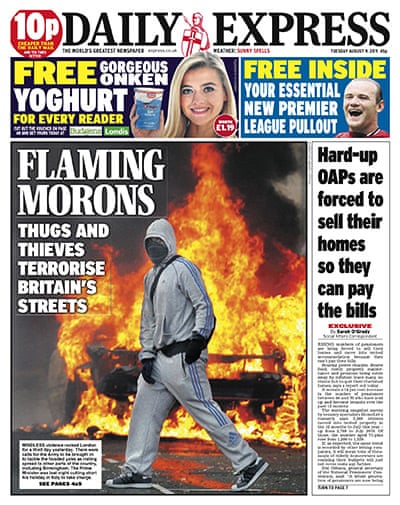Did the news media provide a fair and accurate representation of British youth during the 2011 riots?
Despite the fact that the majority of people involved in the London riots were youths, was there a fair and accurate representation of British youth? An example of "British youths are the most unpleasant and violent in the world"[1], this is how the youths were described on the Daily mirror two days after the tragic events took place. The rioters were mainly given a negative representation without any news institution explaining or considering the reasons behind the riots. The national outbreak occurred when the unarmed 29 year old Tottenham resident Mark Duggan was killed by the British police as he suffered from a gunshot wound to the chest, the death of Mark Duggan resulted in peaceful protest which took place outside of Tottenham police station, this later on went to cause a national outbreak amongst the British youth which caused major riots which started off in the streets of London and the proceeded to other cities around the UK, this was a major tragedy for Britain and caused a moral panic across different communities. In this essay there will be an investigation of how the British youth have been represented in the media and how much the negative stereotype of youths is reinforced in the media, there was a variety of different headline and articles published by the major players in British news media. The British newspapers consistently featured dramatic images of what the Daily Mirror called 'young thugs with fire in their eyes and nothing but destruction on their mind', or the Daily Express called simply 'flaming morons'.
Despite the fact that the majority of people involved in the London riots were youths, was there a fair and accurate representation of British youth? An example of "British youths are the most unpleasant and violent in the world"[1], this is how the youths were described on the Daily mirror two days after the tragic events took place. The rioters were mainly given a negative representation without any news institution explaining or considering the reasons behind the riots. The national outbreak occurred when the unarmed 29 year old Tottenham resident Mark Duggan was killed by the British police as he suffered from a gunshot wound to the chest, the death of Mark Duggan resulted in peaceful protest which took place outside of Tottenham police station, this later on went to cause a national outbreak amongst the British youth which caused major riots which started off in the streets of London and the proceeded to other cities around the UK, this was a major tragedy for Britain and caused a moral panic across different communities. In this essay there will be an investigation of how the British youth have been represented in the media and how much the negative stereotype of youths is reinforced in the media, there was a variety of different headline and articles published by the major players in British news media. The British newspapers consistently featured dramatic images of what the Daily Mirror called 'young thugs with fire in their eyes and nothing but destruction on their mind', or the Daily Express called simply 'flaming morons'.


